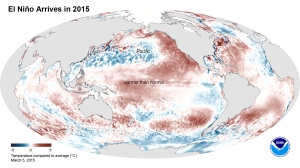
Today the National Weather Service reported that the long-awaited El Niño has arrived in the Pacific Ocean. El Niño occurs when we have above-average temperatures in the Pacific Ocean along the equator. It alters the Pacific weather pattern, which in turn alters our weather patterns over the US. The NWS forecasters say “it is likely (50 to 60 percent chance) that El Niño conditions will continue through summer. ” Due to the weak nature of this event, they are not expecting widespread or strong impacts from this event.
In other news, far southern Illinois was hit this week with another winter storm that passed through Arkansas; southeastern Missouri; southern Illinois, Indiana, and Ohio; as well as most of Kentucky and points beyond. Some of the largest snowfall totals from this event include Grand Chain Dam with 10.0 inches and Brookport Dam with 9.0 inches.







